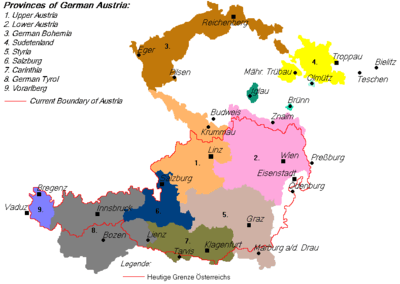Bohemian Forest Region
The Bohemian Forest Region (German: Böhmerwaldgau; Czech: Šumavská župa) is a historical region in the Czech Republic. It includes parts of southwestern Bohemia in the Bohemian Forest once mainly populated by ethnic Germans.
- This article deals with a historical political region. For the Bohemian Forest mountain range, see: Bohemian Forest.
History

The Bohemian Forest Region was historically an integral part of the Habsburg constituent Kingdom of Bohemia but, with the imminent collapse of Habsburg Austria-Hungary at the end of World War I, areas of the Czech-majority Bohemia with an ethnic German majority began to take actions to avoid joining a new Czechoslovak state.
On 11 November 1918, Emperor Charles I of Austria relinquished power and, on 12 November, the ethnic German areas of the empire were declared the Republic of German Austria with the intent of unifying with Germany. The Province of German Bohemia in the north and west was the part of the state including most of the ethnic Germans in Bohemia. However, ethnic German areas of southwestern Bohemia known as the Bohemian Forest Region with their center at Prachatice (German: Prachatitz) were added to Upper Austria instead of German Bohemia. However, the area was taken by the Czechoslovak army by the end 1918.
The status of German areas in Bohemia and Moravia was definitively settled by the 1919 peace treaties of Versailles and Saint-Germain-en-Laye that declared that the areas belong to Czechoslovakia. The Czechoslovak Government then granted amnesty for all activities against the new state.
The region was then reintegrated into the Bohemian Land of the First Republic of Czechoslovakia and remained a part of it until the Nazi dismemberment of Czechoslovakia when it was added to Nazi Bavaria and Austria (Ostmark). After World War II, the area was returned to Czechoslovakia and is now part of the Czech Republic.
During the Cold War the border region was closed off, but with the fall of the Iron Curtain it has become a popular tourist destination with 1.8 million visitors per year.[1]
See also
- German Austria
- Origins of Czechoslovakia
- Sudetenland
References
- Markus Leibenath; Ewa Korcelli-Olejniczak; Robert Knippschild (14 May 2008). Cross-border Governance and Sustainable Spatial Development: Mind the Gaps!. Springer Science & Business Media. p. 155. ISBN 978-3-540-79244-4.